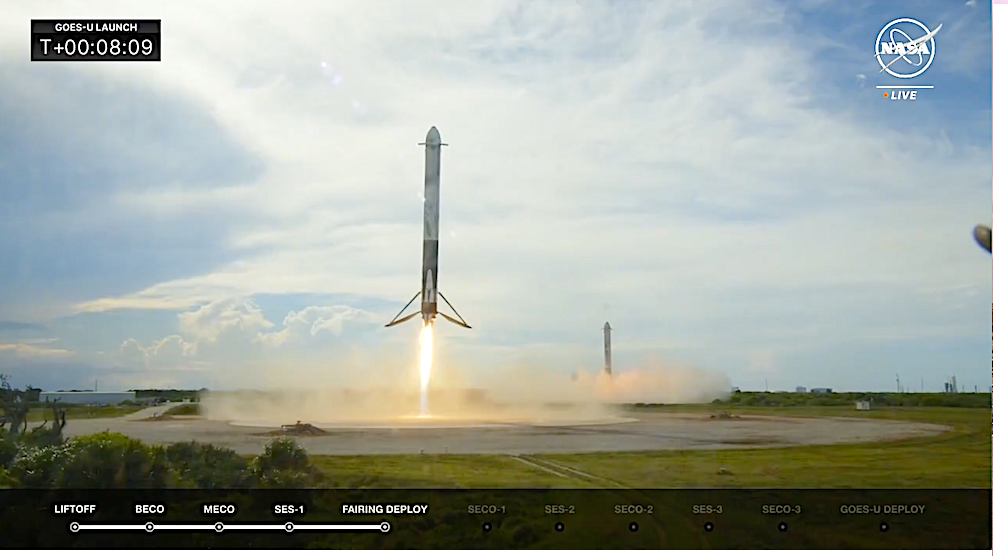
On Tuesday, June 25 at 5:26 p.m. ET, Falcon Heavy launched the National Oceanic and Atmospheric Administration’s (NOAA) GOES-U mission to a geostationary orbit from Launch Complex 39A (LC-39A) at NASA’s Kennedy Space Center in Florida. In addtion the event included a most impressive double booster landing of the Falcon Heavy’s side boosters (see below).
The GOES-U satellite will orbit above the Earth’s equator at approximately 35,700 km (22,236 mi) observing weather patterns in the contiguous USA, Central and South America, and Atlantic Ocean. GOES-U is part of NOAA’s most sophisticated Geostationary Operational Environmental Satellites (GOES) series and will assist weather forecasters and climate researchers with real-time high-resolution imagery, earlier detection of severe weather that could save lives, and tropical cyclone forecasts. The weather satellite also carries a suite of space weather instruments that will be used to detect solar storms early and help predict their possible impacts.
GOES-U hosts a suite of instruments that improve the detection of approaching space weather hazards. The Solar Ultraviolet Imager (SUVI) and Extreme Ultraviolet and X-ray Irradiance Sensors (EXIS) provide imaging of the sun and detection of solar flares. The Compact Coronagraph-1 (CCOR-1) images the solar corona (outer layer of the sun’s atmosphere) to detect and characterize coronal mass ejections (CMEs). CCOR-1 is a new instrument for GOES-U and is part of NOAA’s Space Weather Follow On mission.
The Space Environment In-Situ Suite (SEISS) and Magnetometer monitor, respectively, energetic particles and the magnetic field variations that are associated with space weather. Together, observations from these instruments contribute to space weather forecasts and early warning of disruptions to power utilities and communication and navigation systems as well as radiation damage to orbiting satellites.

This was the first launch for Falcon Heavy’s two side boosters. Following booster separation, the boosters successfully landed on SpaceX’s Landing Zones 1 and 2 (LZ-1 and LZ-2) at Cape Canaveral Space Force Station in Florida.

The Advanced Baseline Imager (ABI) is the primary instrument on the GOES-R Series satellites for imaging Earth’s weather, ocean and environment. Forecasters use ABI data for a wide range of applications related to severe weather, hurricanes, aviation, natural hazards, the atmosphere, ocean and cryosphere.
The Geostationary Lightning Mapper (GLM) is the first operational lightning mapper flown in geostationary orbit. Developing severe storms often exhibit a significant increase in lightning activity and GLM data can help forecasters focus on initial thunderstorm development and intensifying severe storms before they produce damaging winds, hail or even tornadoes.
GOES-U will provide critical atmospheric, hydrologic, oceanic, climatic, solar and space data for advanced detection and monitoring of environmental phenomena that threaten the security and well-being of everyone in the Western Hemisphere.
- Hurricane track and intensity forecasts
- Early warning of severe storms and tornadoes
- Fire detection, monitoring, and intensity estimation
- Identification of lightning strikes most likely to ignite fires
- Detection of low clouds and fog
- Monitoring of atmospheric river events that can cause flooding and mudslides
- Monitoring of smoke, dust and aerosols
- Data for air quality warnings and alerts
- Data for aviation route planning and reducing weather-related flight delays
- Detection of volcanic eruptions and monitoring of ash and sulfur dioxide
- Detection of heavy rainfall and flash flood risks
- Sea surface temperature data for monitoring fisheries and marine life
- Monitoring of vegetative health
- Data for long-term climate variability studies
- Detection of meteors entering Earth’s atmosphere
- Detection of coronal holes, solar flares, and coronal mass ejection source regions
- Characterization of size, velocity, density and direction of coronal mass ejections
- Warning of space weather hazards responsible for communications and navigation disruptions and power blackouts
- Monitoring of energetic particles responsible for radiation hazards
SpaceX’s Falcon Heavy to launch second NOAA’s GOES-U weather satellite Tuesday after leak causes delay

NOAA and SpaceX have finally set a date to launch the last satellite of the GOES-R Series into geostationary orbit on June 25 after a lengthy delay due to a rocket booster leak. The launch is to take place at Kennedy Space Center, Florida, 2:16 – 4:16 PM PSDT.
The Geostationary Operational Environmental Satellite-S Series (GOES-S) is the second of the next generation of geostationary weather satellites. The four satellites of the series will provide advanced imaging with increased spatial resolution and faster coverage for more accurate forecasts, real-time mapping of lightning activity, and improved monitoring of solar activity. The cost is $90Million.


NOAA called this launch “monumental” and claimed its network of Geostationary Operational Environmental Satellites is “the nation’s most advanced weather observing and environmental monitoring satellite system.”
GOES-U is the fourth and last satellite to join the series. Once in orbit, it will be renamed GOES-19. From 22,236 miles above the equator, GOES-19 will continuously observe weather systems across the Western Hemisphere. It will replace GOES-16 in the GOES-East orbit.
The view from GOES-East and West stretches from the west coast of Africa to New Zealand and from near the Arctic Circle to the Antarctic Circle, according to NOAA.
According to weather officials, there’s a 30% chance of favorable weather conditions at the time of the launch. The forecast calls for a temperature of 86°F, few clouds, 24% cloud cover and a wind speed of 17mph.
The Launch Complex 39A has witnessed the launch of 180 rockets, including 179 orbital launch attempts, while Kennedy Space Center, Florida, has been the site for 238 rocket launches.
